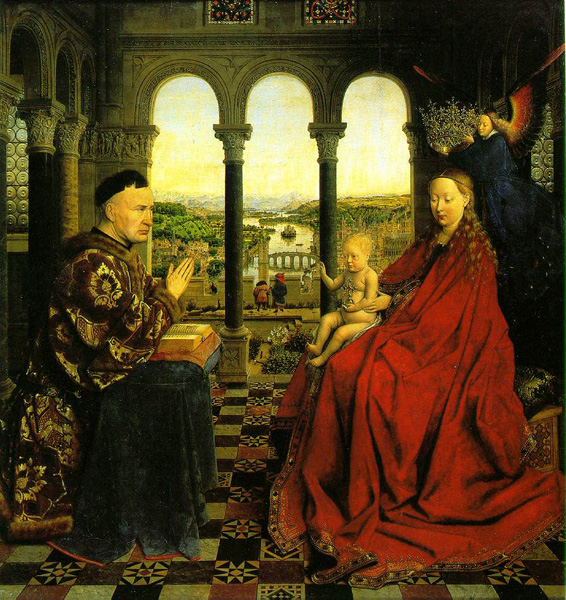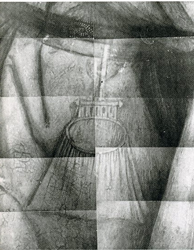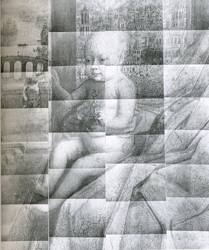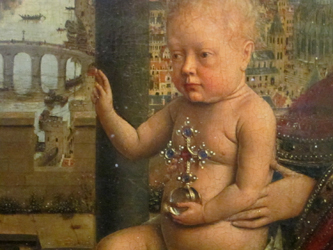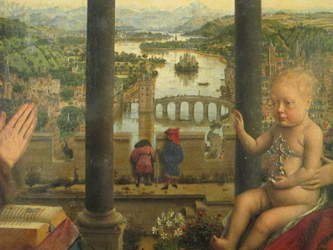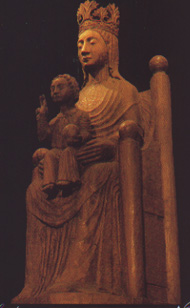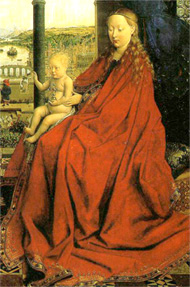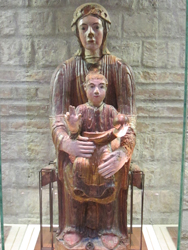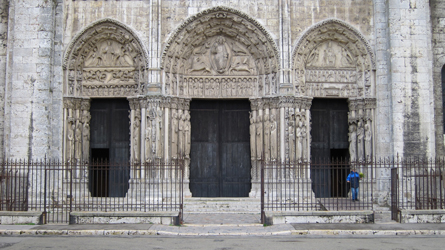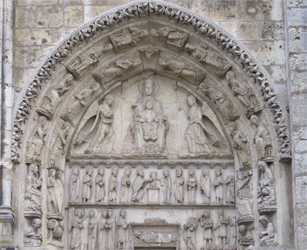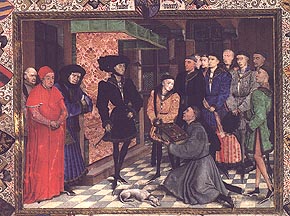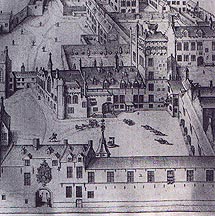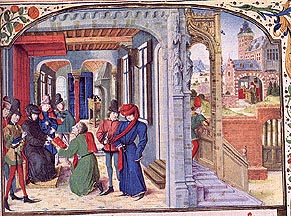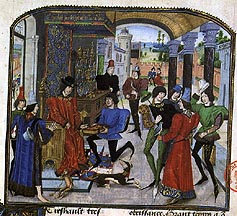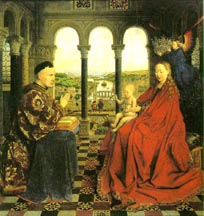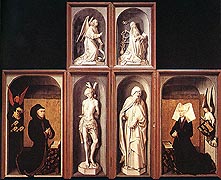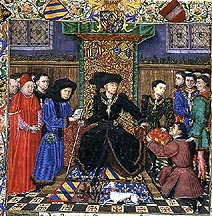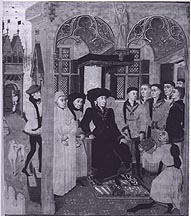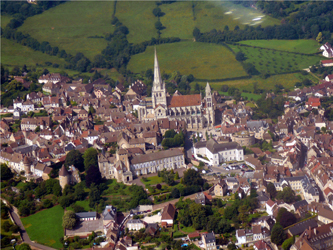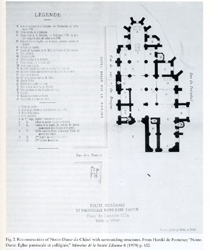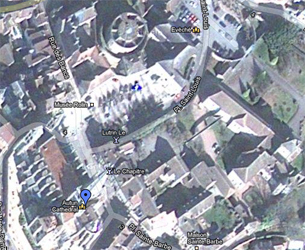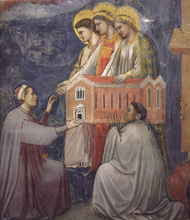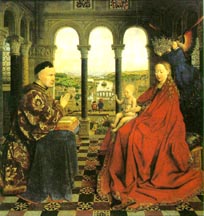
|
|||
Click on Hotspots to see details |
|||

|
|||
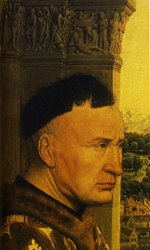
|
|||

|
|||

|
|||
|
|||
| Van Eyck's representation of the Virgin in the Rolin Madonna is based on a tradition of images known as the Throne of Wisdom or Sedes Sapientiae, in which the Christ Child sits very formally in the lap of His mother. The image on the left is from the church of St. Philibert of Tournus. It exemplifies a twelfth century version of the image. | |||
| Royal Portals of Chartres Cathedral, c. 1150. The Incarnation tympanum with the Sedes Sapientiae surrounded by archivolts representing the liberal arts. | |||
|
Duke Philip the Good being presented with the Chroniques de Hainaut, 1448-52
|
|||
Princenhof, Bruges, Engraving from A. Sanderus, Flandria Illustrata, 1644 edn. Discussed in the Introduction to Burgundy. |
|||
Paris, Bibliothèque nationale, fr. 331: Histoire de la conquete de la Toison d'Or or Histoire de Jason (see Burgundian Frontispieces) |
|||
Images of Nicholas Rolin It is striking the number of representations of Nicolas Rolin that have come down to us. What follows are a number of the major examples. It is important to note that in the case of the van Eyck, the exterior of the Beaune Last Judgment, and the preparations of his body for burial, Rolin had control of his representation, whereas the frontispiece presentation images were dictated by others. Compare the social identities of Nicolas Rolin in these images. |
||
Craig Harbison, Jan van Eyck: The Play of Realism , 2nd edition, p. 107: When he [Nicolas Rolin] died in the town of his birth [Autun] in 1462, aged eighty-six, he decreed an elaborate three-day mourning rite 'en publique vue du monde' as well as his final burial costume: a white shirt, rich doublet, hose, new shoes, a velvet robe, a sword buckled on one side, a dagger on the other, golden spurs on the feet, a hood at the neck, a hat on his head, and above all a golden pin on the front of his hat. The inscription on Nicholas Rolin's tomb slab read: CY GISENT NOBLE PERSONNES MESSIRE\ NICOLAS ROLIN CHEVALIER SEIGNEUR DAUTHOMES\ ET DAME GUIGONNE DE SALINS SA FEMME\ PATRONS DEGLISE DE CAENS ET LESQUELS\Y ONT FONDE LES SEPT HEURES CANONIAUX\ MESSES ET AUTRE DIVINS OFFICES ET\ TRESPASSERENT ASSAVOIR LEDIT MESSIRE\ NICOLAS LE XVIII IOUR DE IANVIER MIL\ QUATRE CENT SOIXANTE ET UNG ET LADITE DAME \ GUIGONNE LE...IOUR DU MOIS DE\...LAN MIL CCCC ET LXX...PRIES DIEU\POUR EUX. (Here lies the noble person lord Nicolas Rolin knight and lord of Autun and Lady Guigonne de Salins his wife, patrons of the church of Caens and have fonded there the seven canonical hours , masses, and other divine offices and sinners the said lord Nicolas the 18th day of January 1461 and the said lady Guigonne the ...day of the month of ... the year 1470...Pray to God for them.) |
||
Aerial view of Autun. The cathedral of St. Lazare dominates the city of Autun. Its eight-sided tower and chevet were constructed by the Cardinal Jean Rolin, the son of Nicholas, after a lightning strike in 1468. The entrance facade of Notre-Dame du Châtel faced the front of the north side of the cathedral. |
||
Nicholas Rolin was especially devoted to the small parish church in Autun, Notre-Dame du Châtel, that was adjacent to the house of Nicholas Rolin's great-grandfather. Nicholas was baptized and buried in this church. In 1428 Rolin requested funds from the Duke of Burgundy for the reconstruction of a chapel dedicated to St. Sebastian that included an altar donated by Rolin's maternal ancestors. In the 1430s Rolin continued to subsidize the reconstruction of the church. Following Rolin's appeals, the pope in 1450 elevated the status of the church from parish to collegiate with Rolin being designated the official patron. Rolin endowed masses and costly furnishings. It is believed that Rolin gave to the church a crown likely intended to be worn by the Virgin of Autun that was placed on the altar in the chapel of St. Sebastian. Van Eyck's painting was probably placed on the wall to the left of the altar in this chapel. Giotto, Enrico Scrovegni presenting the Arena Chapel to the Virgin Mary, c. 1305. |
||
Ecclesiasticus 24 and link to the Hours of the Blessed Virgin Mary
Articles:
Laura Gelfand, "Painting, Nobility, and Posterity: Wealth and the Ruin of Nicolas Rolin's Reputation," Journal of the Historians of Netherlandish Art , I
Laura D. Gelfand and Walter S. Gibson, "Surrogate Selves: The "Rolin Madonna" and the Late-Medieval Devotional Portrait,"Simiolus, 29, 2002, pp. 119-138
John L. Ward, "Disguised Symbolism as Enactive Symbolism in Van Eyck's Paintings," Artibus et Historiae, 15, 1994, pp. 9-53.
Anne Hagopian van Buren, "The Canonical Office in Renaissance Painting, Part II" More about the Rolin Madonna, " The Art Bulletin, 60, 1978, pp. 617-633.
Christine Hasenmueller McCorkel, " The Role of the Suspended Crown in Jan van Eyck's Madonna and Chancellor Rolin," The Art Bulletin, 58, 1976
pp. 516-520
De Clerq, Wim, Jan Dumolyn, and Jelle Haemers, ""Vivre Noblement': Material Culture and Elite Identity in Late Medieval Flanders," Journal of Interdisciplinary History 38, 1 (Summer 2007): 1-31.
Craig Harbison, "Realism and Symbolism in Early Flemish Painting," The Art Bulletin, 66, 1984, pp. 588-602.
